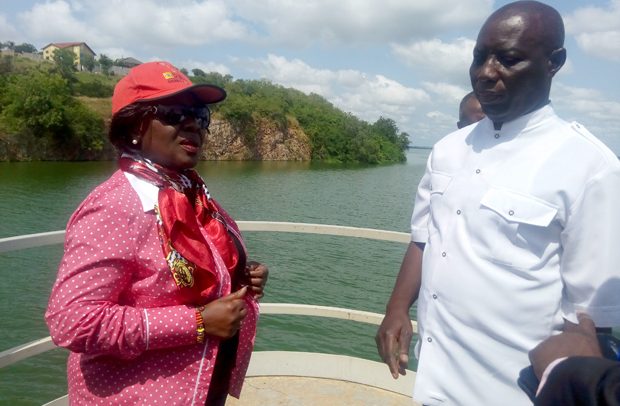Cecilia Dapaah with Augustine Atigbire at the Weija Dam
Minister of Sanitation and Water Resources, Cecilia Abena Dapaah, has given a one-week ultimatum to management of Ghana Water Company Limited (GWCL) to clean the Weija Dam, which has virtually been inundated by garbage.
The minister made the call on Tuesday when she toured the dam which supplies about 60 million gallons of water daily to Accra.
The outspoken minister was unhappy with the level sanitation at the dam which was constructed in 1978.
Ms Dapaah said, “I am sorry, station manager, you have failed; the place is dirty.”
Under the leadership of the Station Manager, Augustine Atigbire, rubber bags, old metals, wood and other unwanted materials have completely taken over the dam.
Ms Dapaah also realized that writings on the signage, which are supposed to warn visitors, are not visible, with no effort being made by the company to address the anomaly to ensure safety.
The minister pointed out that it was unacceptable for GWCL to be producing water for the general public from a dirty environment.
That, she said, was because water can impact the health of individuals and ought to be handled with care.
According to her, “Good water is life. When the water is not properly treated and you drink it you know the consequence.”
She warned that actions that cause water-borne diseases should not be encouraged, saying “littering is forbidden. Untidiness is forbidden.”
During a press briefing at the dam before heading to the Kpone Water Treatment Plant, she told journalists that “all I want to know is that we are safe with the water that the Ghana Water Company produces.”
Challenges
Managing Director of GWCL, Dr Clifford Briamah, pointed out the challenges faced by personnel at the Weija Dam and the likely threat to water distribution in Accra.
He said out of a total of 12 filters required for the proper functioning of the water treatment plant at Weija, only eight are operational, adding that four broke down about five years ago.
He said $30 million was needed to address the situation, saying “if care is not taken and one of the remaining eight filters breaks down water supply would be reduced by 30 percent.”
By Melvin Tarlue


